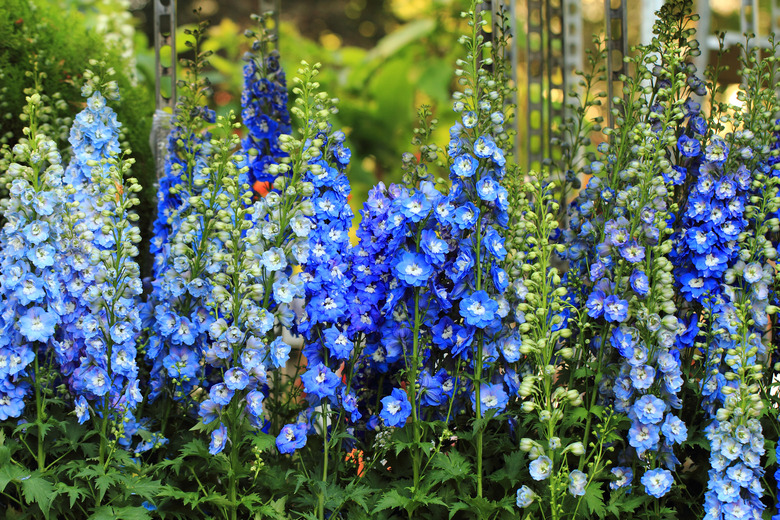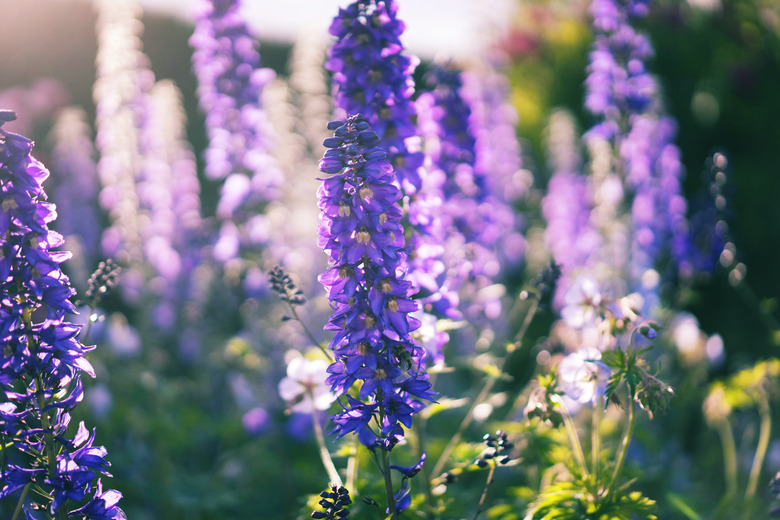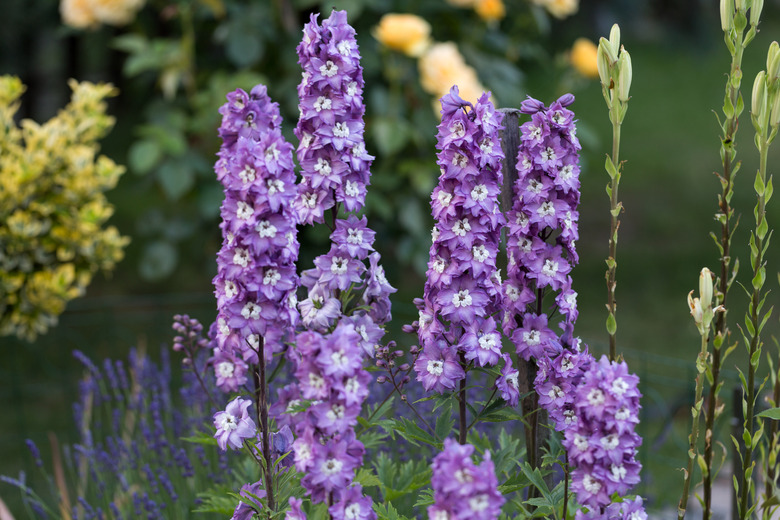How To Grow Delphiniums
We may receive a commission on purchases made from links.
The term "showy" is often used to describe plants, but nowhere is it more apt than when trying to capture the unique look of delphiniums (Delphinium spp.). The tall, graceful spikes of the plant are packed with dozens of small flowers. Blue is the color most often associated with delphiniums, but cultivars with pink, crimson, white and purple flowers are also available.
As striking as the plants are to behold, they can be very finicky and high maintenance. They do not like hot, dry summers, preferring cooler temperatures and moist soil. Maintaining a regular watering schedule to keep the soil moist is important. They often require protection from strong wind and heavy rain. Staking taller varieties keeps the plants from flopping over.
While they can require a lot of work, delphiniums, if maintained properly, offer two blooming seasons: one at the start of summer in June and July and another in late summer into fall. They also attract hummingbirds and butterflies.
Best Uses for Delphiniums
Best Uses for Delphiniums
Delphiniums are often associated with cottage gardens, especially those that receive full sun for most of the day but have some afternoon shade.
- Because of their height, they work best at the rear of a perennial border or in the center of a circular garden.
- Mass plants as space allows, but even small groups of three or five will become a garden focal point.
- Dwarf varieties make good potted plants placed in an outdoor living area or around an entrance to the home. They are a favorite plant for cutting gardens.
Tip
After the first set of flowers fade in June or July, cut flower stalks to the ground. This often leads to a second round of blooms in early to mid fall.
How to Grow Delphiniums
How to Grow Delphiniums
|
Common Name |
Delphinium |
|
Botanical Name |
Delphinium elatum |
|
When to Plant |
For starting seeds indoors, sow them eight to 10 weeks before the last spring frost date. For growing outdoors, sow directly into the garden in late spring. In warm areas, such as zone 7, seedlings can be planted in the fall. |
|
USDA Zones |
3-7 |
|
Sun Exposure |
Full sun to partial shade, especially in very hot climates |
|
Soil Type |
Well-draining soil; slightly alkaline soil |
|
When It's in Trouble |
The plant shows stunted growth with yellow foliage, usually due to a lack of fertilizer. |
|
When It's Thriving |
The spikes have a strong upright stance and vibrant flowers. |
Starting Delphiniums From Seed
Start seeds indoors eight to 10 weeks before the last spring frost date. Delphinium seeds get a boost from a cold start, so store them in the refrigerator for about a week before sowing.
- Place the seeds in the trays of a seed-starter kit and cover them with about 1/8 inch of starter soil.
- Keep the soil moist and at about 70 degrees Fahrenheit. Seedlings take about three to four weeks to emerge.
- Move the seedlings to a sunny windowsill or place them 4 inches under a fluorescent grow light. Raise the light as the plants grow.
- Keep the plants under the light for 16 hours each day and in the dark for the remaining eight hours.
- Move young plants from small cells to 4-inch pots when they develop two pairs of true leaves.
- Before moving the seedlings to the garden, harden off the young plants. Hardening off is a process of gradually introducing the plants to outside conditions. Do this by placing the plants in a sheltered outdoor spot, such as a porch, that is out of direct sunlight and protected from the wind. Bring the plants indoors if a frost threatens them. The process takes about one week.
- To sow directly into the garden, prepare the soil by mixing in organic matter, such as compost, with the top 8 to 12 inches of soil.
- Sow the seeds and cover them with 1/8 inch of soil. Keep the soil moist. Seedlings should emerge in about three to four weeks.
- When they develop three sets of leaves, thin the plants to 12 to 18 inches apart.
Starting Delphiniums From a Seedling
Growing delphiniums from a seedling is a bit less complicated:
- Prepare the soil by turning over the top 12 inches and mixing it with organic matter, such as compost.
- Space the plants 12 to 18 inches apart. The hole should be twice the diameter of the pot containing the young plant.
- Unpot the plant and loosen the roots with your fingers.
- Place it in the hole so that the top of the root ball is level with the surrounding area.
- Water the plant and cover the area around the plant with a few inches of mulch to help keep the soil moist.
- Keep the mulch away from the stems of the plant because stems covered with mulch encourage insect pests and decay.
In What Zone Do Delphiniums Grow Best?
In What Zone Do Delphiniums Grow Best?
Delphiniums are listed for USDA zones 3 to 7, but it is important to remember that the plant does not respond well to hot conditions. For instance, the plant struggles during summers in St. Louis, which is in zone 6. So, the microclimate, or local climate condition, is very important. In warm areas, place the plants where they get full morning sun, but some afternoon shade will be welcome.
Planting delphiniums against fences or the side of your house can help protect them from strong winds. They need the protection because the stems are hollow.
When Should You Plant Delphiniums?
When Should You Plant Delphiniums?
Most delphiniums are planted in the spring, but in warm areas, they can be planted in the fall. If you live in a temperate climate, start seeds indoors around Labor Day for November plantings. Delphiniums sown in the fall should bloom the following spring. When planting young plants, work on a cloudy day or late in the afternoon. This can help prevent transplant shock.
Delphiniums usually produce flowers in the first year but not always. They come into their own with a full complement of flowers and multiple stems during the second year.
Soil, Sunlight, and Water Recommendations for Delphiniums
Soil, Sunlight, and Water Recommendations for Delphiniums
Caring for your delphiniums once they're in the ground is essential. Here's what they require to thrive:
Soil Requirements for Delphiniums
Delphiniums like nutrient-rich, well-draining soil. They can tolerate neutral to slightly alkaline soil as measured on the pH scale. This scale measures the soil's balance between acidity and alkalinity on a scale from 1 to 14, with around 7 being neutral. Before planting, it is a good idea to know the pH of your soil, as it can help determine what nutrients the soil is lacking.
Some garden centers can test soil, as can your local county extension service. There are also DIY testing kits, and a 3-in-1 meter goes even further by testing pH, soil moisture and the sunlight available for your plants.
Delphiniums are heavy feeders, so it is important to mix organic matter with the soil at planting time. During the growing season, side-dress the plants with compost or balanced liquid fertilizer every two to three weeks.
Sunlight for Delphiniums
Plant delphiniums in areas that receive direct sun for six to eight hours per day. In very hot areas, the plants prefer not to get too hot and crave the afternoon shade.
Water Requirements for Delphiniums
Water deeply at least once a week until the young plants are established. During the season, keep the soil moist but not sopping wet. The top 1 inch of soil should be moist at all times. Water early in the day to avoid loss from evaporation and to help the leaves dry quickly. Ground-level soakers or drip irrigation systems get the water to the base of the plant efficiently.
How to Propagate Delphiniums
How to Propagate Delphiniums
Spring is the best time to take cuttings for propagating delphiniums. Once the plants in your garden begin to grow, take a 4-inch cutting from one of the side shoots.
- Push some of the soil out of the way and cut below the soil line. You want to get the green shoot and some of the brown base material. Remove all but a few top leaves from the cutting.
- Dip the bottom of the cutting in rooting hormone and plant in a small pot that contains potting mix. Place the pot out of direct sun and keep the soil moist.
- When you start to see new growth in about three or four weeks, that is an indication that the root system is starting to develop. You should be able to plant in the garden in late summer or early fall.
Delphiniums should be divided every three years or so. Dig up the root ball and use a soil knife or sharp shovel to separate the outer sections from the heart of the root system. Replant the divided sections to create more plants.
How to Winterize Delphiniums
How to Winterize Delphiniums
Continue watering the plants through the fall until the ground freezes. This will provide moisture to the roots over the winter. After the first hard frost, cut back the plant to about 6 inches from the ground and remove debris from around the base of the plant. Slugs can be a problem for delphiniums, and good garden housekeeping can discourage them.
Add 3 or 4 inches of natural mulch to conserve moisture and protect the crown of the plant during the cold months. Don't mulch with large whole leaves because they can form soggy blankets that can harm the plant. If you want to use leaf mulch, cut up the leaves with a lawn mower first.
Common Pests and Other Problems for Delphiniums
Common Pests and Other Problems for Delphiniums
Slugs and snails can attack and even destroy young delphinium plants. You will notice small holes in the leaves where they feed. Keep the area free of weeds and other debris around plants to discourage them. Folk wisdom recommends burying a shallow saucer of beer so that the lip is even with the soil. The pests will crawl in and drown in the brew.
Other recommendations call for spreading diatomaceous earth around the plants so the jagged edges of the material cut into the bodies of the critters. There are also commercial baits and poisons available as well as slug and snail traps.
Cyclamen mites destroy plants by sucking the juices from leaves and stems. They can only be seen with a magnifying glass, but you can spot their damage because the plant may not bloom, and the leaves will look distorted and cupped. The mites like hot, dry conditions, so keep the plants well watered to avoid an infestation. There are miticides that can destroy the mites.
Leafhoppers are insects that spread disease. They can be controlled with insecticidal soap or a commercial insecticide.
Common Diseases for Delphiniums
Common Diseases for Delphiniums
Powdery mildew is a fungal disease that shows as a white growth on the top of the plants' leaves. The leaves will eventually turn yellow and die. Apply a fungicide when you first notice the disease.
Aster yellows is a virus where leaflike tissue forms where there should be flowers. The disease is spread by leafhoppers. Remove infected plants and control the leafhoppers, because there is no cure for this virus.
Delphiniums can be harmed by fungal and bacterial pathogens that lead to the rotting of stems, crowns and roots. Some of the signs include leaves that turn yellow, blackened stems and a smelly ooze on the stems. Infected plants should be destroyed. Help prevent the conditions that foster these diseases by avoiding overhead irrigation.


